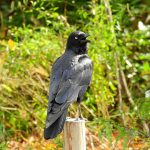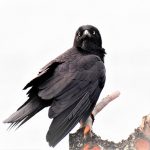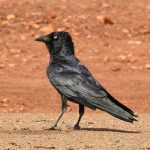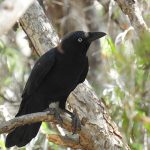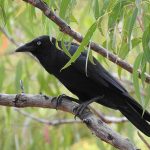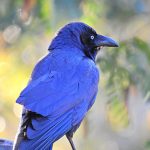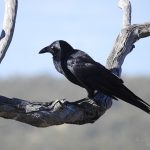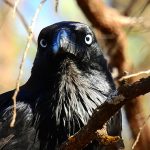TORRESIAN CROW
Torresian Crow
The Torresian crow is one of Australia’s most intelligent and adaptable birds — a glossy black presence that watches us from powerlines, coastal mangroves and city parks, often far more closely than we realise.
Quick Facts
| Feature | Detail |
|---|---|
| Scientific name | Corvus orru |
| Family | Corvidae (crows, ravens, jays and allies) |
| Size | ~45–50 cm long |
| Weight | Around 500–650 g |
| Lifespan | Often 10+ years in the wild (longer in care) |
| Conservation status | Not threatened (common and widespread) |
Where They Live
The Torresian crow is mainly a bird of northern Australia and nearby regions.
Distribution
- Australia:
- Northern Western Australia
- Northern Territory
- Queensland (very common)
- Extends down the east coast into New South Wales, especially around coastal and inland towns
- Beyond Australia:
- New Guinea
- Some surrounding islands
They are particularly common in:
- Coastal habitats and estuaries
- Open woodlands and savannahs
- Farmland, towns and cities
Where humans create open spaces, food waste and safe roosting spots, Torresian crows often move in and thrive.
What They Look Like
At first glance, a Torresian crow looks simply “black”, but close up, there is a lot more going on.
Plumage and Build
- Entirely glossy black with a slight purple or green sheen in strong sunlight
- Medium-sized crow: smaller than the large Australian raven, but still a substantial bird
- Strong, straight bill, not as heavy or deep as the raven’s
Eye Colour
One of the keys to identifying adult Torresian crows is their eye:
- Adults: a striking, pale white or bluish-white iris that stands out against the black feathers
- Juveniles: dark brown eyes that gradually pale as they mature
Bill and Throat
Compared with ravens:
- Torresian crows have a neater throat without the long, shaggy hackles (throat feathers) that ravens show, especially when calling
- The bill is large but relatively slim, not as heavy or “roman-nosed” as an Australian raven
How to Tell It from Other Australian Crows and Ravens
Australia has several very similar black corvids, which can be confusing. In the north, though, the Torresian crow is usually the main species you will see.
Useful clues:
- Torresian crow: a clear, often repeated “caah, caah, caah” or slightly nasal “uk-uk-uk”. It is generally shorter and less drawn-out than a raven’s call.
- Australian raven: more of a long, wailing “aah… aah… aah-aaaah” with a mournful tail to the note.
Throat feathers
- Torresian crow: throat feathers fairly smooth
- Ravens: obvious, shaggy throat hackles that puff out when calling
Range
- In tropical and subtropical northern Australia, a crow-like bird is very likely to be a Torresian crow.
- In southern and inland regions, one of the raven species becomes more likely.
Despite these clues, even experienced birdwatchers sometimes struggle with corvid identification; the call and location are often the most reliable tips.
Behaviour and Intelligence
Crows are among the most intelligent birds in the world, and the Torresian crow is no exception.
Social Life
- Often seen in pairs or small family groups, sometimes forming larger flocks around good food sources or roosts
- Pairs tend to be territorial during breeding season, defending the area around their nest
- Outside breeding season, they may roost communally in tall trees, especially around towns and wetlands
Problem-Solving and Tool Use
Crows are superb problem-solvers, and the Torresian crow displays this in many ways:
- Opening hard-shelled food (like crabs, shellfish or large insects) by dropping them from height onto hard surfaces
- Learning to follow human routines — for example, turning up around schools, picnic areas or rubbish tips at predictable times
- Rapidly working out new food sources, such as pet food bowls, roadkill, or newly harvested crops
This adaptability is part of why they have done so well in human-modified landscapes.
Voice and Communication
The Torresian crow’s call is a constant feature of the northern Australian soundscape.
- Typical call: a series of hoarse, medium-pitched “caa, caa, caa” notes
- They use different calls for:
- Alarm (sharper, more urgent notes when a predator appears)
- Contact between pair members or family
- Aggression or territorial disputes with other crows
Their calls carry well through open country and across urban areas, often heard long before the bird is seen.
Diet and Feeding
Torresian crows are omnivores and highly opportunistic.
What They Eat
- Animal foods:
- Insects, spiders, small reptiles, small mammals
- Carrion (dead animals), including roadkill
- Eggs and nestlings of other birds when they can access them
- Plant foods:
- Grains, seeds and nuts
- Fruits, especially from native and ornamental trees
- Human-related foods:
- Rubbish and food scraps
- Pet food
- Spilled grain and agricultural waste
Their willingness to eat almost anything helps them survive in both natural and heavily altered environments.
Breeding and Family Life
The breeding season varies with climate and region but is often concentrated in the dry season or times of plenty in northern Australia.
Nesting
- Nests are usually built high in trees, often in forks near the crown
- Made of sticks and twigs, lined with softer materials such as grass, bark and sometimes even human-made materials like paper or fabric
- A typical clutch is 3–5 eggs, pale with darker blotches
Raising Young
- Both parents share in incubating the eggs and feeding the chicks
- Young birds stay with their parents for some time after fledging, learning how and where to find food
- Older offspring from previous years sometimes help feed younger siblings, a behaviour known as cooperative breeding
This extended family system helps young crows learn complex survival skills in a changing environment.
Habitat and Ecosystems
Torresian crows play several roles in their ecosystems:
- Scavengers: by feeding on carrion, they help clean up animal remains and reduce the spread of disease
- Seed dispersers: when they eat fruit and move across the landscape, they may help spread seeds
- Predators: they take insects and other small animals, and sometimes raid nests, which can bring them into conflict with people who are very attached to particular bird species
In natural settings, these roles are part of a balanced system. In highly disturbed or urban environments, they can become unusually abundant, sometimes altering the local dynamics between species.
Relationship with People
Because they live so closely with us, Torresian crows often inspire strong opinions.
Perceived Problems
Some people see them as:
- Noisy, especially at dawn roosts
- Messy, when they scatter rubbish or pull apart bags looking for food
- Threats to other wildlife, particularly when they raid nests
However, these behaviours often increase where:
- Rubbish and food waste are left easily accessible
- Habitat changes favour crows over more sensitive species
Benefits
At the same time, they:
- Clean up carrion and organic waste
- Control some insect populations
- Provide an opportunity to observe complex bird behaviour up close, even in cities
Their presence can be a reminder of how adaptable nature is, but also how strongly our choices shape which species thrive around us.
Conservation Status
The Torresian crow is currently common and not considered threatened.
Key reasons for its success include:
- High intelligence and behavioural flexibility
- Broad, omnivorous diet
- Ability to exploit agricultural land, towns and cities
However, “common” does not mean unimportant. Widespread species also play critical roles in ecosystems and can be early indicators of environmental change.
Subtle Conservation Messages
Even a thriving species like the Torresian crow can benefit from thoughtful management of the landscapes we share:
- Responsible waste management (covering bins, reducing litter) can limit unnaturally high crow numbers in cities and protect more vulnerable species.
- Protecting large trees for nesting and roosting supports not only crows but a wide range of birds, mammals and insects.
- Maintaining natural habitats such as mangroves, open forests and wetlands ensures that crows remain part of a rich community of species rather than dominating simplified urban environments.
By paying attention to a familiar bird like the Torresian crow, we sharpen our awareness of the broader health of our ecosystems.
In Summary
The Torresian crow is:
- A highly intelligent, adaptable corvid of northern and eastern Australia and nearby regions
- Recognisable by its glossy black plumage, pale adult eyes and relatively neat throat
- An omnivorous scavenger and predator, strongly associated with human settlements as well as natural habitats
- Common and not threatened, yet still an important part of Australia’s ecological story.

